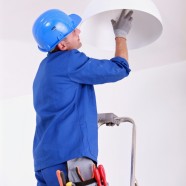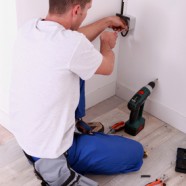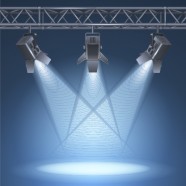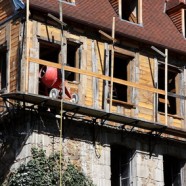How to Get Electrical Energy Savings Through Small Habit Changes
With electrical energy costs rising every year, it makes sense to do what you can to limit the power your household is using. While updating an entire house can significantly lower your energy usage, smaller changes can add up to surprisingly large savings. Contract a professional electrical contractor to come up with a plan for small, gradual changes to make on your home. An experienced electrician can alert you to spots where you’re wasting power as well as newer technology to waste older, power-hungry versions you already have installed. Any one of these changes can result in enough electrical energy savings to lower your monthly power bill, and combining a few could end up saving you hundreds of dollars every year.
Save on Heating and Cooling
Your HVAC system is one of the biggest energy users in your home, giving you lots of leeway in which to save money. Even small changes in your habits can add up to large electrical energy savings every month. It’s common knowledge that you should set your thermostat around 72 degrees F in the winter and 78 degrees in the summer. This is the average good compromise between comfort and energy savings. That’s a great idea, but what about the times you aren’t even in the house or actively using the space? When the whole family goes to school and work, there’s no sense in keeping your living space at an optimal temperature. The same goes for winter nights, when everyone is snuggled under blankets. Changing the indoor temperature during these down times is a great idea, but who can remember to do it every day? When your electrical contractor installs a programmable thermostat, you can set the ideal temperatures for multiple times each day, and it will automatically change the temperature for you. No more having to remember changes every morning and night.
Save on Electric Lights
Electric lights are, in most homes, the biggest drain on the electrical budget. They’re everywhere, in every room, and it’s easy to forget to turn them off. This can add up to double-digit wastage every single month. The best way to combat this problem is to have your electrician install a programmable light timer. Find ones that work on multiple lights, and set them to go off when you know the house is empty. If you have an outdoor light for security reasons, set a timer there to go off after a few hours, or install a motion sensor for even more savings.
Turning the light off will save you money, but you’ll find even more electrical energy savings when the lights themselves save you money, even when they’re on. According to Energy Star, if every home in the country replaced one bulb with a more efficient one, we’d collectively save about $600 million in energy costs each year. LED light bulbs might seem pricey at first, but considering the fact that they use a fraction of the power compared to traditional bulbs, plus they last for years, they’re really a power bargain.
Save on Electric Appliances
Even the most frugal person can miss out on savings by skipping a trick or two. One way to catch every spot you miss to get the biggest savings possible is by having your electrical contractor install an electrical usage monitor. This device checks where the electricity is going in your home and how much of it is wasted. The programmable system will check:
- Energy vampires, those appliances that suck power even when they’re turned off
- Large appliances such as refrigerators and space heaters that use more power than they should
- Random lights that are constantly left on when they shouldn’t be
- Sudden periods of higher than average usage, which can indicate wasteful behavior or changes in your electrical usage
Once the system is installed, a quick check once a day will tell you where your power is going, and what items you can change in order to save even more money.
Read More4 Signs You Need a Commercial Electrical Technician
Most business people try to avoid calling in service people for as long as possible to avoid that hit on the bottom line. For some parts of your business, such as landscaping or décor, this makes perfect sense. When it comes to electrical problems, though, putting off repairs can endanger your customers and employees as well as cause significant risk of fire. Not every glitch in your circuit breaker is reason to call a commercial electrical provider, but if you’re having significant issues with these clues, it’s time to call a pro. You’ll save money in the long run, because equipment in good shape lasts longer, plus you’ll have peace of mind knowing your business is safe from electrical fires.
#1: Lightning Protection
Businesses in Florida are especially vulnerable to fires from lightning strikes, as this is the lightning capitol of the country. If your business is lacking lightning protection technology, your first priority should be to call and have a system installed. If you’re thinking of unattractive tall lightning rods of the past, don’t worry about it. Today’s lightning protection comes in the form of air terminals, short poles usually measuring about 12 inches high, that unobtrusively blend in with your roof line. A commercial electrical professional can plan the right system of air terminals for your building’s height and square footage, and will install the system so that it won’t detract from the looks of your building. Once you have a lightning protection system in place, call your commercial insurance agent. Most companies give a discount on their premiums when lightning safety systems are installed.
#2: Electrical Outlets
Electrical outlets are so common that it’s easy to think they’ll last forever. Like any other piece of equipment in your building, though, they wear out and break down eventually. Some signs of outlet wear are simple indications that they need to be updated to accommodate more modern usage. Some other signs are clues that there is actually electrical problems in your wiring, and have to be taken care of immediately. In either case, it’s best to contact a professional to get an opinion on your particular situation. These include:
- Loose outlets
- Warm outlets
- Brown spots around switches
- Noisy switches
- Sparks when a switch is turned on or off
- Outlet plugs with two prongs instead of three
#3: Other Clues
Outlets and switches may be a major source of electrical problems that crop up in your business, but troubles can show up anywhere you’ve got wiring. If your lights dim when the air conditioning or heat pump switch on, this can be a sign of inadequate wiring. If you constantly get shocked when you touch an appliance, you need to have the area inspected. Frayed wiring, loose switch plates, a fuse box instead of a circuit breaker, and even the smell of burning can be a clue that you need to contact a commercial electrical technician to have him inspect your electrical system.
#4: Possible Fixes
Calling for electrical repair doesn’t necessarily mean ordering a complete redo on your electrical system. You may only need to have one or two outlets or switches replaced. You and your electrical professional may decide to have your circuit breaker updated to handle a growing load, or you may need the wiring tested throughout your building. The key is to have a professional look at the problem so you can make a decision that’s right for both your safety and your business’s bottom line.
Read MoreGet Your Electrical Contractor to Install Vital Safety and Security Measures
In order for your home or business to be usable, it not only needs to be beautiful but also safe and secure. An electrical contractor is your go-to person when it comes to renovating a house or installing wiring on a new business, but that’s not all he can do for you. An electrician can advise you about safety and security additions you can use in your home, as well as installing them once you decide on a project. Homes and businesses may have different purposes, but in many ways their security and safety needs are very similar.
GFI Sockets
Unregulated electrical current can pose a danger to curious small children as well as employees in a commercial kitchen. When a person is being shocked, it’s the continued effect of the electric current that does real damage to their health. A GFI or Ground Fault Interruptor, is designed to stop the electrical current running to a particular outlet if there is an abnormal diversion of the current. If anything untoward happens while the outlet is in use, a circuit breaker built into the outlet immediately cuts off the power, preventing further injury. GFI outlets are especially common in places where water is present such as bathrooms and kitchens in the home, as well as commercial kitchens and restrooms in businesses of all types.
Emergency Lights
Emergency lighting is the smallest and least expensive form of lighting in case of a power outage, but it provides enough illumination to get yourself and others around you outside safely without running into sharp furniture corners or hot commercial ovens. Emergency light sets are installed over doorways and contain rechargeable batteries connected to a power source. Passive until the power goes out, they then turn themselves on, showing the way to every exit in the room. All emergency exit lights have a lighted face, but many of them also include small spotlights to add further illumination to the room. These lights are mandatory in almost all businesses, but can be installed in homes, as well.
Floodlights
A good percentage of the theft in businesses and homes happens after dark. Thieves feel safer burglarizing buildings when it’s more difficult for people to see them. One of the best ways to prevent this from happening is to light up the outside of your building to make it much easier for people to spot anything illegal that may be happening. Floodlights can be installed in a number of different locations, depending on the landscaping on your property:
- On top of a tall pole
- On the corners of the building
- Hidden in shrubbery
- Attached to sturdy tree branches
Of the two basic types of floodlights, most businesses choose a permanent light, one that runs all night long and is set on a timer. Many homeowners opt for the other type, one that has a motion sensor. The light doesn’t work if nothing is in the yard, but if the motion sensor detects anything moving around on the property, the bright lights will come on, shining on whatever is moving outside.
Alarm Systems
Burglar alarms are the most common basic defense against breaking and entering. In order for an alarm system to work correctly, a licensed professional such as an electrical contractor should do the installation. Most home alarms are connected to entrances such as doors and windows, especially those on the first floor. Alarms on the second floor are less common, but can be installed for additional protection. Businesses install alarms on all doors and windows, and some businesses invest in additional motion sensor technology, especially in the case of stores with valuable merchandise on display. Most alarm systems will sound some sort of noise or warning when they are set off, and all of them should be connected to a phone line so that an automated message can be sent to the police or alarm monitoring company.
Read MoreYour Business Needs a Generator 20 KW or Larger
If your business is in the Northeast, you probably remember the 2003 Blackout that affected 7 large states, plus the province of Ontario, Canada? Even if you weren’t in the affected region, the stories of gas lines and closed businesses stand as an object lesson for yourself and every business owner. Power outages happen, and when they do your business will shut down unless you have an alternate power source.
If you’re in any kind of service industry and keep your power on, a blackout can be one of the most lucrative times of the year. Restaurants, carryout establishments, corner stores with emergency supplies, and gas stations are just some of the businesses offering essential services when no one else in the neighborhood has power in their homes.
Ensuring your power stays on when others don’t can be one of the smartest business decisions you can make. Generators have gotten less expensive in the last two decades, but they’re still an investment. Most businesses will need a generator 20 KW or larger. Here’s how to tell the size of backup system you need.
Essential Equipment and Systems
Your first step is to identify systems and equipment that are essential for your business in order to keep operating. Most places will need:
- Heating, ventilation, and air conditioning
- Major restaurant appliances such as freezers and ovens
- Computers and other office equipment
- Sump pumps and well water pumps
- Lights and alarms
Fuel
Almost all alternate power sources run on natural gas or diesel fuel. Each system has its own advantages and disadvantages, depending on the size of your generator, the part of the country in which you live and work, and your building’s specifications. Speak with a utility company representative to get input on each type of system.
Building Codes and Requirements
Before having a permanent backup generator installed, check with your building owner if you’re leasing the business. He may have concerns about having a permanent installation on his property. If you own your business, look into city property laws dealing with hazardous materials and emergency power equipment. Find out all pertinent building codes to ensure you’re compliant after the work is done. Some cities may regulate the use of manual or automatic transfer switches, or they may have concerns about the means for manual disconnection in case of utility company workers trying to restore power. Check with your electric company for electrical codes and safety guidelines before beginning installation.
Making a Decision
Armed with all this information, contact a licensed electrical contractor. He will work with you to determine the size of backup generator you need to keep your business operating during a prolonged blackout. Once you’ve decided on a generator and installation plan, your contractor will safely install the appliance, making sure it’s safe and up to code with both local and national regulations.
Every emergency is different, and in Florida and other east coast states there may be times when evacuating is a smarter decision than staying home and keeping your business open. But for times when it’s safe to stay but you’re dealing with a prolonged power outage, the convenience of having a backup generator 20 KW or larger as an alternate power source will prove that it’s a good investment for your business.
Read MoreElectrical Contractor Costs: Factors in Renovating Your House
Older homes in south Florida may have classic looks, but renovating them will almost always include replacing old wiring and fuse boxes. The amount of renovation needed depends on safety and building code requirements. Depending on whether you’re replacing a fuse box or rewiring an entire guest house, your electrical contractor costs can vary widely. A wide variety of factors affect your final costs, depending on how much you can do yourself, and how complicated the final project becomes.
Do it Yourself
If you’ve successfully completed other home projects, you may feel as if you can do a home rewiring project, saving money for other parts of the renovation. If your only upgrade is to add a ceiling fan or to replace a switch plate, that may be true, but getting a professional is best for anything more elaborate than that. The safety considerations alone are enough to steer you in this direction, but the cost of fixing mistakes made through inexperience can be higher than the original price of the job done right.
Supplies
The cost of your job will depend partly on what supplies you’ll need to finish the job. These can include:
- Filing and pulling a permit to wire your home
- Wiring, outlet covers, switches, and breaker box
- Conduit
- Supplies for repairing walls if needed for access to old wiring
Building Permits
While the cost of a building permit for wiring your renovation job will be the same whether a professional electrician pays for it or you do, a commercial electrical contractor knows exactly what kind of permits are needed and how the local permit process works. He knows exactly what information and paperwork will be needed in order to receive a permit, and which permits you’ll need to get in order to make your project legal and up to code in your neighborhood.
Electrical Panels
If you have one of the classic Art Deco older homes in south Florida, and it hasn’t had its electrical wiring updated in the last few decades, you may be living in a house with an old-fashioned fuse box. Not only is this expensive, it can also be unsafe to use. It’s definitely a sign that the wiring may need replacing. Fuse boxes should always be replaced with modern circuit breakers, which can handle today’s electrical demand much better than its older cousin. Putting in a new circuit breaker will definitely factor in electrical contractor costs, but it can pay for itself in safety features and possible home insurance premiums.
Estimating and Lowering Materials Costs
While you can’t know the final total for renovation and rewiring costs until the job is done, it’s possible to estimate the costs and make an effort to reduce them during the work process. New outlets and switches will have to be installed when a room is rewired, but if you can reuse your old outlet covers and switch plates you’ll save some money on those supplies. If your ceiling fan is still in good condition, your electrical contractor will be able to install it back in place once the wiring is finished without any additional cost for a new fan.
Replacing any outlets or switches can cost between $70 and $120 per item, depending on where the items are placed and whether other wiring has to take place in order to do a successful job. The copper wire itself can be one of the most expensive elements in a renovation project. It can run over $1,000 for a small bungalow-type house, and over $3,000 for larger, multi-bedroom family homes.
Read MoreStandby Power Generators: Shouldn’t I Just Rent?
By the time the middle of summer approaches, most Florida residents are thinking about what they need to top off their hurricane supplies. Every year, residents on the Atlantic coast prepare for hurricanes, tropical storms, and the resulting power outages that threaten the area. Most emergency supplies are relatively inexpensive, and can even be used up if the hurricane season passes without a major storm, but one major item is neither: standby power generators.
If you live in an area that’s subject to regular, sustained power outages, it makes sense to keep a standby power supply around, or at least to know where to get one if the lights go out. You might look at the relative costs of buying a standby generator vs. renting one, and decide to take a chance at not needing it often enough to make it worth the expense of purchasing your own. Unfortunately, when the power goes out for more than a few hours, your options will be limited when it comes to getting electricity back into your home.
Cost Comparison
Costs vary depending on brands and your part of the country, but the average rental cost of a medium-sized portable generator runs between 5 and 10 percent of the cost of buying one. If you can find a generator on sale, as they usually are after hurricane season is over, you can close that gap considerably. The bottom line is that when you buy standby power generators, you have the option of waiting around to find the best deal. If you wait until the power goes out to rent one, you’re a captive audience, forced to pay whatever the dealer is charging during an emergency. And it’s doubtful that there will be discounts that week.
Availability
Hardware stores and big box retailers can only stock a certain number of rental generators, in order to make the space cost-effective. If you’re lucky enough to get to the store right after the power goes out, you may be able to rent one of the few samples they keep around. When their supply is gone, they won’t open cases to convert sales models to rental units. They’ll simply switch to a sales-only model, at the full, non-discounted price. Depending on where you live, you may not even have much of a chance of finding a rental generator in the case of a long-term power outage. Even if you do, the chances that it will be the right size for your needs and budget are very small.
Maintenance
When you buy your own standby generator, you take responsibility to keep up the maintenance each season, making sure it’s in top condition so that it works well when it’s needed. After all, an emergency generator has to be a reliable last resort for keeping your home and belongings safe and comfortable. Reputable dealers may service their generators, but there are no guarantees. One lazy employee or busy week where things got forgotten, and you can have a broken generator on your hands with no way to replace it with a working model. You don’t know how the last renter treated it, and you don’t know if the maintenance schedule was followed correctly. With your own model, however, you know you’ve got the best possible chance of having power on all through the outage.
The Right Size
Even if you find an available standby generator at your local store during a power outage, it may not be big enough to power all the equipment you want to keep running. Most emergency rentals are powerful enough to run your refrigerator/freezer, a few lights, and some fans. If you’d like your life during the blackout to be more than simply camping out in your house, you probably want a larger standby generator. The only way to guarantee this is to buy your own before the power goes out. You can find generators that run your computers and television all the way up to whole-house models that let you forget that anything’s wrong in your neighborhood. When you buy your own standby generator, you decide the level of comfort you need when the lights go out.
Read More






Recent Comments